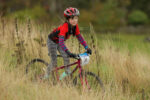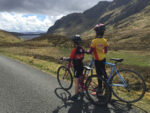Training for the Etape Caledonia
Part 1: Setting targets
If you are new to cycling and have already entered the 2011 Etape Caledonia then well done! You are half way there. If you haven’t, then what are you waiting for!
Sportives, races, charity rides, and, in fact any cycling event that sets a challenge is an ideal way to improve your fitness and motivate you to train harder. Once you’ve booked, there is no going back and if you are raising money for charity then you have that extra motivation to push yourself that extra bit further.
But where do you start?
A good place to start is at the end. Get a diary and mark the date of the 2011 Etape Caledonia in it, then work backwards, counting the weeks until you reach present day. This will give you a defined period of time that can then be broken down into more manageable training blocks.
Each of these blocks should be focussed towards your ultimate goal, but can be stepping stones along the way, each with their own target. Write your ultimate goal for the event at the start of your training diary. This may be as general as “completing the event” or more specific, as in “completing the event under a certain time”. Once you have an overall goal then you should take some time working out what you will need to do to achieve it. If you have never cycled 81 miles before and your overall goal is just to complete the event, then a large focus of what you will need to do will be simply building endurance and gradually increasing the miles you cycle. If it is to complete the event in a specific time then you may want to consider where you can make the biggest improvements, such as group riding or improving hill climb speed. This process will allow you to manage your training in realistic chunks that can be less daunting than a larger timescale. Importantly, you should also factor in real life commitments such as holidays, family time and other foreseeable activities. If you plan ahead, then you will be able to fit your training around these things, rather than having them disrupting your training. For example a two week holiday could coincide with a rest period where you could maybe still get some sort of physical activity that complements your cycling, such as using the hotel pool.
An example may be that you start training on the 1st October 2010 giving you six clear months of training. Your goal is to complete the event in less than 6 hours and you are aware that you lose time by not climbing as quickly as others and from being nervous about cycling in a group.
Your basic training plan may look something like this:
| Period | By the end of this block I will have: |
| Block 1: Oct – Nov ’10 | Increased my distance from 10 miles to 25. |
| Block 2: Nov – Dec ’10 | Joined a local cycling club. Increased my endurance. |
| Block 3: Jan ’10 | Improved my group riding skills. |
| Block 4: Feb ’10 | Ridden my first 60 mile ride |
| Block 5: Mar – Apr ’10 | Improved my climbing speed |
| Etape Caledonia – 15th May 2011 | |
You will notice that there is a two week period prior to the event that has not yet been factored in. There is a reason for this and we will come to this in later instalments.
Once you have an overall plan you can then make this as detailed as you want from breaking each block down into individual training weeks, each with its individual goal. You may even want to break this down further into each day and plan ahead what each training day will achieve. This is very effective if you have very little time to put aside for training. By pre-planning you may be able to identify times where you could add a cycle commute in as part of your daily training.
Part two: Weekly training plans; coming soon






